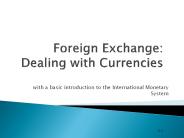Foreign Currency Exchange Rates - PowerPoint PPT Presentation
1 / 11
Title:
Foreign Currency Exchange Rates
Description:
Foreign Currency Exchange Rates Currency Markets An exchange rate tells you how much of one currency you must give up to get a unit of another currency. – PowerPoint PPT presentation
Number of Views:255
Avg rating:3.0/5.0
Title: Foreign Currency Exchange Rates
1
Foreign Currency Exchange Rates
2
Currency Markets
- An exchange rate tells you how much of one
currency you must give up to get a unit of
another currency. This is also called the nominal
exchange rate. - The real exchange rate is the rate at which a
person can trade the goods and services of one
country for the goods and services of another
country.
3
Calculating the real exchange rate
- Real exchange rate
- Nominal exchange rate X domestic price
- foreign price
4
- Suppose a bushel of American rice sells for 100,
and a bushel of Japanese rice sells for 16,000
yen. And suppose the nominal exchange rate is 80
yen/dollar. What is the real exchange rate of
Japanese rice to American rice? - Real Exchange Rate
- (80 yen/dollar) x (100 per bushel of American
rice) - 16,000 yen per bushel of Japanese rice
- _8,000 yen per bushel of American rice
- 16,000 yen per bushel of Japanese rice
- ½ bushel of Japanese rice per bushel of
American rice
5
Macroeconomic focus on the price level
- Macro exchange rates focus instead on the
relative price levels of each country. - Real exchange rate (e x P) /P
- Where P is the price index for a U.S. market
basket, and P is the price index for a foreign
market basket, and e is the nominal exchange rate
between U.S. and foreign currencies.
6
Purchasing power parity and the law of one price
- The theory states that a unit of any given
currency should be able to buy the same quantity
of goods in all countries. - That is because, if a currency bought more in one
place than in another, clever people would take
advantage of arbitrage opportunities to buy a
good for less in one country and sell it in
another, with the only difference being the
different values of currencies in each country.
7
PPP
- This processbuying low and selling highwould
continue until the prices were the same in the
two markets. - Thus the theory of PPP says that a currency
should have the same purchasing power in all
countries. At least, it should have the same real
value in every country. - But that also means that the nominal exchange
rates between the currencies of the two countries
depends on the price levels in those two
countries.
8
Inflation and currency exchange rates
- The nominal exchange rate between two currencies
must reflect the different price levels in those
countries. - BUT, when the central bank prints large
quantities of money, that money loses value in
terms of the amount of foreign currency it can
buy. - When one country experiences inflation, prices in
that country rise faster relative to prices in
other countries.
9
Big Mac Index
- Started in half-jest by The Economist, the Big
Mac Index measures exchange rates based on the
price of a Big Mac in each country. Its now
published regularly. - The predicted exchange rate is the one that makes
the cost of a Big Mac the same in both countries.
10
(No Transcript)
11
Other determinants that affect currency
appreciation and depreciation
- Consumer tastes
- Relative incomes
- Relative inflation
- Speculation































